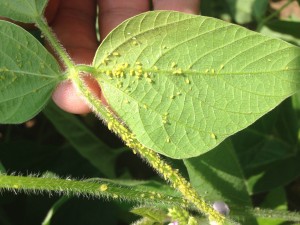Soybean Aphid in North Carolina?
go.ncsu.edu/readext?311153
en Español / em Português
El inglés es el idioma de control de esta página. En la medida en que haya algún conflicto entre la traducción al inglés y la traducción, el inglés prevalece.
Al hacer clic en el enlace de traducción se activa un servicio de traducción gratuito para convertir la página al español. Al igual que con cualquier traducción por Internet, la conversión no es sensible al contexto y puede que no traduzca el texto en su significado original. NC State Extension no garantiza la exactitud del texto traducido. Por favor, tenga en cuenta que algunas aplicaciones y/o servicios pueden no funcionar como se espera cuando se traducen.
Português
Inglês é o idioma de controle desta página. Na medida que haja algum conflito entre o texto original em Inglês e a tradução, o Inglês prevalece.
Ao clicar no link de tradução, um serviço gratuito de tradução será ativado para converter a página para o Português. Como em qualquer tradução pela internet, a conversão não é sensivel ao contexto e pode não ocorrer a tradução para o significado orginal. O serviço de Extensão da Carolina do Norte (NC State Extension) não garante a exatidão do texto traduzido. Por favor, observe que algumas funções ou serviços podem não funcionar como esperado após a tradução.
English
English is the controlling language of this page. To the extent there is any conflict between the English text and the translation, English controls.
Clicking on the translation link activates a free translation service to convert the page to Spanish. As with any Internet translation, the conversion is not context-sensitive and may not translate the text to its original meaning. NC State Extension does not guarantee the accuracy of the translated text. Please note that some applications and/or services may not function as expected when translated.
Collapse ▲For the second year in a row (that we’ve noticed), soybean aphid has been present in North Carolina. Soybean aphid is the most important insect pest of Midwest soybeans, but is not very prevalent in North Carolina. Soybean aphid is better adapted to northern climates and it’s overwintering host, buckthorn, is not commonly known in the state.
 Last year’s cool and cloudy summer must have created good conditions for soybean aphid, since it could be found throughout the state. This year, a NCSU Entomology graduate student, Brad Fritz, noticed soybean aphid in the Sandhills. Last year, a few fields were at treatable levels (250 aphids per plant) a bit west in the Piedmont. Pure speculation here, but maybe buckhorn is more prevalent here than other areas. Certainly the climate must have something to do with their presence and, perhaps, spread from areas where they are more common. At the most, soybean aphid has seemed to remain more of a curiosity in the state since fields at or near threshold are rare.
Last year’s cool and cloudy summer must have created good conditions for soybean aphid, since it could be found throughout the state. This year, a NCSU Entomology graduate student, Brad Fritz, noticed soybean aphid in the Sandhills. Last year, a few fields were at treatable levels (250 aphids per plant) a bit west in the Piedmont. Pure speculation here, but maybe buckhorn is more prevalent here than other areas. Certainly the climate must have something to do with their presence and, perhaps, spread from areas where they are more common. At the most, soybean aphid has seemed to remain more of a curiosity in the state since fields at or near threshold are rare.


